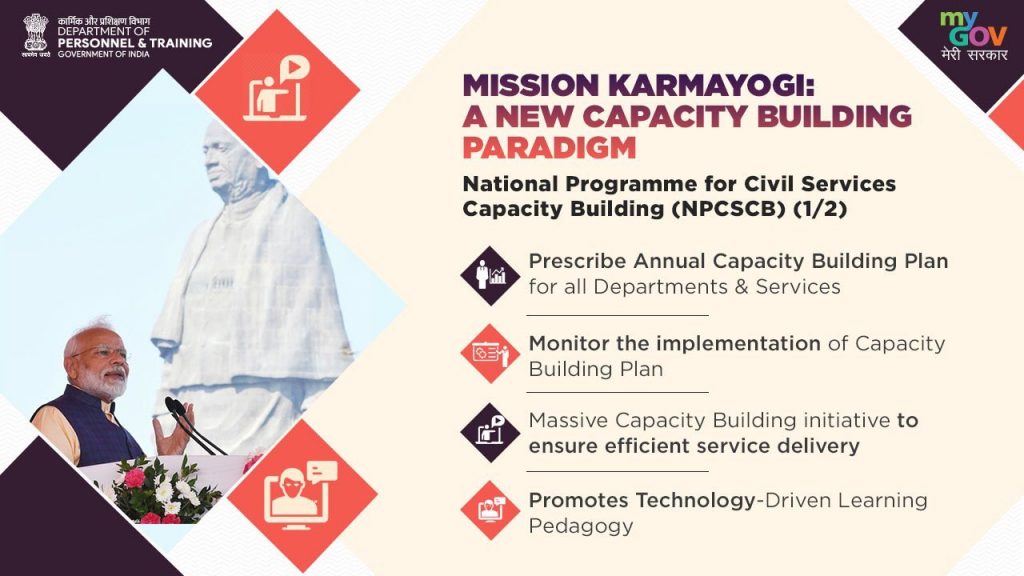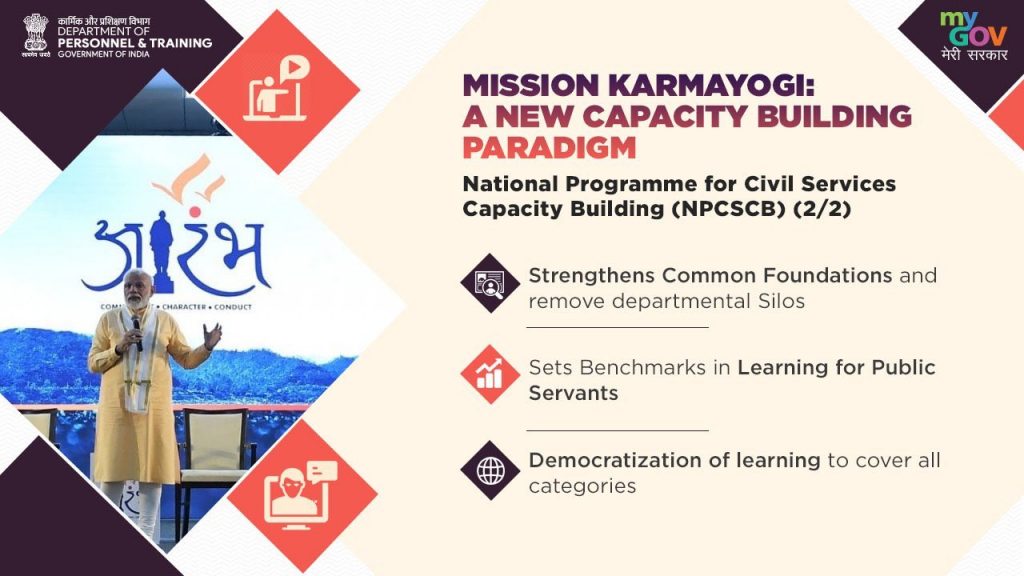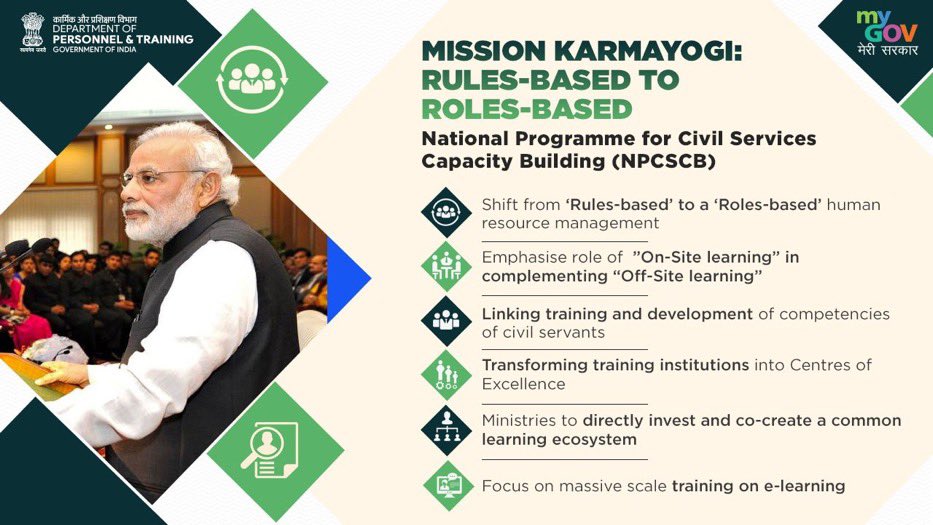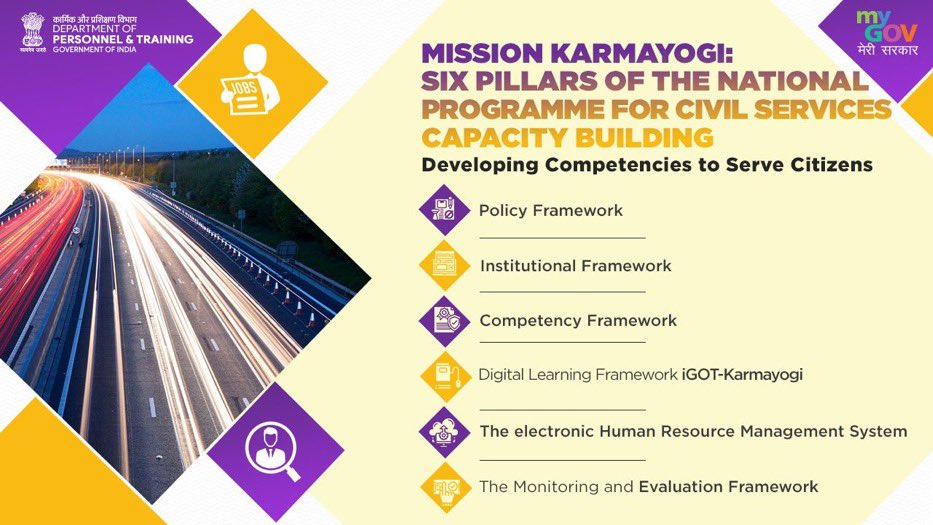Contents
- Mission Karmayogi and NPCSCB
- India is top 50 of Global Innovation Index
- 3rd Annual Leadership Summit of USISPF
- Jeewan Raksha Medals
MISSION KARMAYOGI AND NPCSCB
Focus: GS-II Social Justice, Governance
Why in news?
The Union Cabinet has approved the launch of a Mission Karmayogi – National Programme for Civil Services Capacity Building (NPCSCB).
Introduction
- Capacity of Civil Services plays a vital role in rendering a wide variety of services, implementing welfare programs and performing core governance functions.
- A transformational change in Civil Service Capacity is proposed to be affected by organically linking the transformation of work culture, strengthening public institutions and adopting modern technology to build civil service capacity with the overall aim of ensuring efficient delivery of services to citizens.
Mission Karmayogi – National Program for Civil Services Capacity Building (NPCSCB)
- The NPCSCB will use scale & state of the art infrastructure to augment the capacity of Civil Servants to improve the Human Resource management practices in the Government.
- Mission Karmayogi aims to prepare the Indian Civil Servant for the future by making him more creative, constructive, imaginative, innovative, proactive, professional, progressive, energetic, enabling, transparent and technology-enabled.
- A Public Human Resources Council comprising of select Union Ministers, Chief Ministers, eminent public HR practitioners, thinkers, global thought leaders and Public Service functionaries under the Chairmanship of Hon’ble Prime Minister will serve as the apex body for providing strategic direction to the task of Civil Services Reform and capacity building.
The Framework of NPCSCB
- Prime Minister’s Public Human Resources (HR) Council
- Capacity Building Commission
- Special Purpose Vehicle for owning and operating the digital assets and the technological platform for online training
- Coordination Unit headed by the Cabinet Secretary
Salient Features
- NPCSCB has been carefully designed to lay the foundations for capacity building for Civil Servants so that they remain entrenched in Indian Culture and sensibilities and remain connected, with their roots, while they learn from the best institutions and practices across the world.
- The Programme will be delivered by setting up an Integrated Government Online Training – iGOT Karmayogi Platform.
- It is also proposed to set up a Capacity Building Commission, with a view to ensure a uniform approach in managing and regulating the capacity building ecosystem on collaborative and co-sharing basis.
Core Guiding Principles
- Supporting Transition from ‘Rules based’ to ‘Roles based’ HR Management.
- To calibrate all Civil Service positions to a Framework of Roles, Activities and Competencies (FRACs).
- To emphasize on ‘on-site learning’ to complement the ‘off-site’ learning.
- To create an ecosystem of shared training infrastructure including that of learning materials, institutions and personnel.
Role of Capacity Building Commission
- To assist the PM Public Human Resources Council in approving the Annual Capacity Building Plans.
- To exercise functional supervision over all Central Training Institutions dealing with civil services capacity building.
- To create shared learning resources, including internal and external faculty and resource centres.
- To coordinate and supervise the implementation of the Capacity Building Plans with the stakeholder Departments.
- To make recommendations on standardization of training and capacity building, pedagogy and methodology
- To set norms for common mid-career training programs across all civil services.
- To suggest policy interventions required in the areas of HR Management and Capacity Building to the Government.
iGOT – Karmayogi
- iGOT-Karmayogi platform brings the scale and state-of-the-art infrastructure to augment the capacities of over two crore officials in India.
- The platform is expected to evolve into a vibrant and world-class market place for content where carefully curated and vetted digital e-learning material will be made available.
- Besides capacity building, service matters like confirmation after probation period, deployment, work assignment and notification of vacancies etc., would eventually be integrated with the proposed competency framework.




INDIA IS TOP 50 OF GLOBAL INNOVATION INDEX
Focus: GS-III Science and Technology
Why in news?
- India has climbed 4 spots and has been ranked 48th by the World Intellectual Property Organization in the Global Innovation Index 2020 rankings.
- India was ranked in top 3 in the “Lower Middle-income Economies”.
Details
- It is a remarkable achievement to be in a league of highly innovative developed nations all over the globe.
- The WIPO had also accepted India as one of the leading innovation achievers of 2019 in the central and southern Asian region, as it has shown a consistent improvement in its innovation ranking for the last 5 years.
- The consistent improvement in the global innovation index rankings is owing to the immense knowledge capital, the vibrant start-up ecosystem, and the amazing work done by the public & private research organizations.
- The scientific ministries like the Department of Science and Technology, the Department of Biotechnology and the Department of space have played a pivotal role in the enriching the national innovation Ecosystem.
Role of NITI Aayog
- The India Innovation Index, which was released last year by the NITI Aayog, has been widely accepted as the major step in the direction of decentralization of innovation across all the states of India.
- A constant thrust in monitoring and evaluating India’s position in global rankings has be provided by the NITI Aayog, including the global innovation index.
Global Innovation Index (GII)
- The Global Innovation Index (GII) is an annual ranking of countries by their capacity for, and success in, innovation. It is published by Cornell University, INSEAD, and the World Intellectual Property Organization, in partnership with other organisations and institutions, and is based on both subjective and objective data derived from several sources, including the International Telecommunication Union, the World Bank and the World Economic Forum.
- The GII is commonly used by corporate and government officials to compare countries by their level of innovation.
- The GII is computed by taking a simple average of the scores in two sub-indices, the Innovation Input Index and Innovation Output Index, which are composed of five and two pillars respectively.
- Each of these pillars describe an attribute of innovation, and comprise up to five indicators, and their score is calculated by the weighted average method.
World Intellectual Property Organization (WIPO)
- The World Intellectual Property Organization (WIPO) is one of the 15 specialized agencies of the United Nations (UN) – headquartered in Geneva, Switzerland.
- WIPO was created to promote and protect intellectual property (IP) across the world by cooperating with countries as well as international organizations.
- WIPO’s activities including hosting forums to discuss and shape international IP rules and policies, providing global services that register and protect IP in different countries, resolving transboundary IP disputes, helping connect IP systems through uniform standards and infrastructure, and serving as a general reference database on all IP matters.
- WIPO also works with governments, nongovernmental organizations (NGOs), and individuals to utilize IP for socioeconomic development.
3RD ANNUAL LEADERSHIP SUMMIT OF USISPF
Focus: GS-II International Relations
Why in news?
- Indian Prime Minister shall deliver the Special Key Note Address at the USISPF 3rd Annual Leadership Summit,
- The Theme of the 5-day Summit is “US-India Navigating New Challenges”.
- The theme covers various subjects such as India’s potential in becoming a Global Manufacturing Hub, Opportunities in India’s Gas Market, Ease of Doing Business to attract FDI in India, Common Opportunities & Challenges in Tech Space, Indo-Pacific Economic issues, Innovation in Public Health and others.
US-India Strategic Partnership Forum (USISPF)
- The US-India Strategic Partnership Forum (USISPF) is a non-profit organization, with the primary objective of strengthening the U.S.-India bilateral and strategic partnership.
- The Executive Board came together in 2017 to establish USISPF with the purpose of enabling business and governments to collaborate and create meaningful opportunities that can positively change the lives of citizens.
- Dedicated to strengthening economic and commercial ties, USISPF plays a significant role in fostering a robust and dynamic relationship between the two countries through policy advocacy that will lead to driving economic growth, entrepreneurship, employment-creation, and innovation to create a more inclusive society.
JEEWAN RAKSHA MEDALS
Focus: GS-II Governance
Why in news?
Hon’ble President of India has awarded 3 Railway- Protection Force (RPF) personnel with Jeevan Raksha Padak awards.
Jeevan Raksha Padak
- Jeevan Raksha Padak series of awards are given to a person for meritorious act of human nature saving lives from drowning, fire, or mine accidents.
- The Jeevan Raksha Padak may be awarded to members of the armed forces, police, or fire services when recognizable acts take place outside beyond the course of their duty.
- The medal may be awarded posthumously.
- It was established in the 1960s.
The award is given in three categories, namely:
- Sarvottam Jeevan Raksha Padak,
- Uttam Jeevan Raksha Padak and
- Jeevan Raksha Padak.



